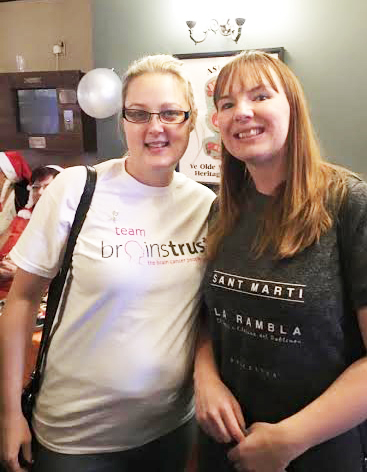Last month, The Brothers Arms in Sheffield opened it’s doors for a charity day to raise funds for our support service. The day was organised by Samantha and Simon Marper, who know all too well the devastating impact a brain tumour diagnosis has upon a family.
 Samantha was diagnosed with a brain tumour in 2009. Since then Samantha has undergone surgery twice, has seen her tumour stabilise, only to grow again and, on top of this, has battled numerous infections of the brain. Recently, she was given devastating news.
Samantha was diagnosed with a brain tumour in 2009. Since then Samantha has undergone surgery twice, has seen her tumour stabilise, only to grow again and, on top of this, has battled numerous infections of the brain. Recently, she was given devastating news.
“Just a few weeks ago I was given the news I thought I was ready to hear. We’d feared the results and I thought I’d be prepared to hear the worse but nobody could ever prepare themselves to be told that their tumour had changed from being slow growing to a malignant, aggressive brain tumour that wasn’t curable. I’m now starting radiotherapy to slow down the growth”
Throughout their journey, Samantha and Simon have received support from brainstrust and have attended the Meet Ups that the charity holds regularly in the region. It was Simon’s idea to do something positive. And he went all out.
“Simon decided to put his mind into organising a fundraising day to raise awareness and money for brainstrust- a charity who are solely supporting brain tumour patients and their friends and relatives. We had raffles, cake, balloon modelling, fake glitter tattoos and all round fun for the whole family. The support that people showed on the day was just incredible”.
Pete Burchill, Support Specialist for brainstrust in Sheffield went along to the event.
“Samantha and Simon’s charity day was amazing. It’s events like these that help fund vital areas of brainstrust’s support service, such as our Meet Ups, and the incredible amount of money raised from the day is being spent helping more families get back on their feet following a terrifying diagnosis”
In total, the day went on to raise an incredible £3,400, including an extremely generous donation of £2000 from the company Stagecoach.
Thanks so much Samantha and Simon, and to all involved. You’re amazing.

If you too would like to do something positive for brainstrust, so that we can support more people in the UK to feel less afraid, less alone and more in control in the face of a terrifying brain tumour diagnosis, then we’ll help you with it every step of the way. Visit our team brainstrust page to pick one of our challenges or simply get in touch with tessa@brainstrust.org.uk if, like Samantha and Simon you’d like to plan one of your own.



